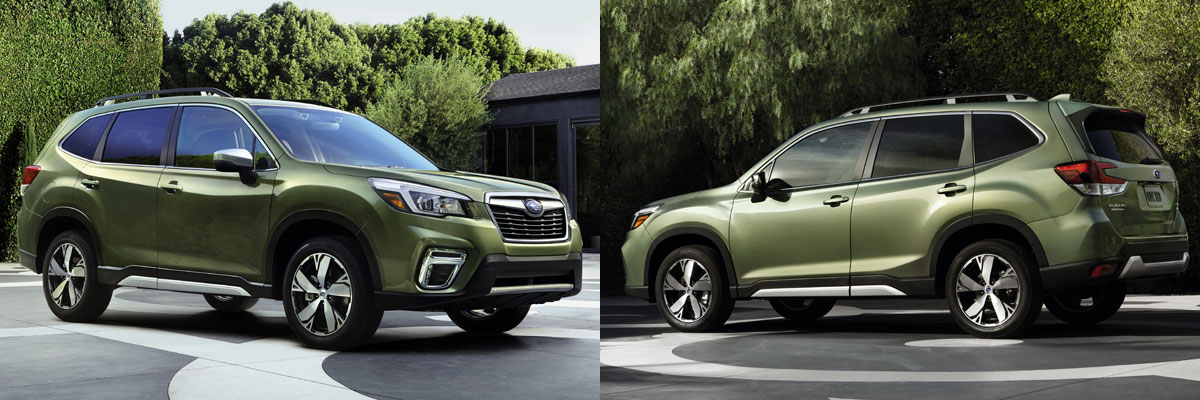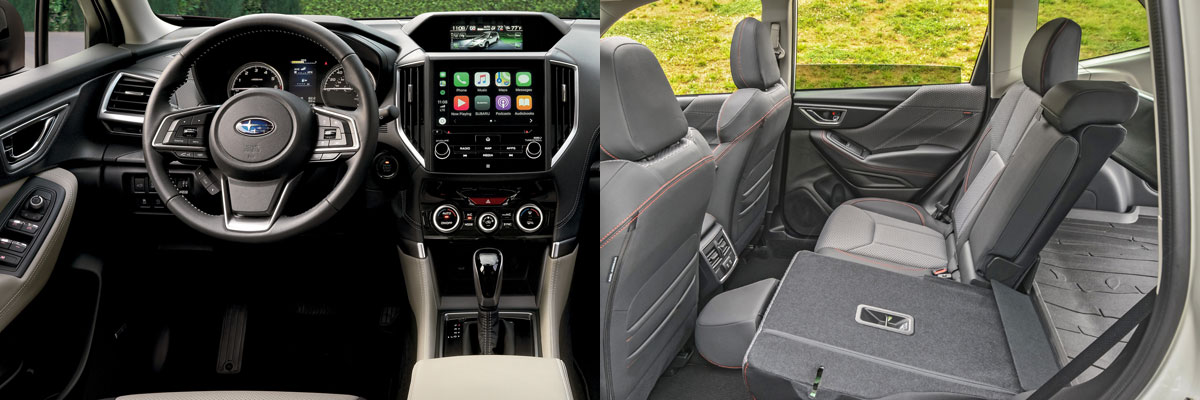Forester, Subaru's strongest seller, was most recently redesigned in 2019. Now in its fifth generation, this compact crossover wagon was first introduced in 1997. Passenger capacity remains at 5 on twin front buckets and a 3-place rear bench. All-wheel drive is standard. Competitors include the Chevrolet Equinox, Ford Escape, Honda CR-V, Hyundai Tucson, Jeep Compass, Mazda CX-5, Nissan Rogue and Toyota RAV4.
Starting at $27,090, five trim levels are offered: Base, Premium, Sport, Limited and Touring. All are powered by a 2.5-liter 4-cylinder engine that makes 182 horsepower and 176 pound-feet of torque. Sole transmission is a continuously variable automatic. Sport and touring models get a driver-selectable 7-speed manual shift mode with steering-wheel-mounted paddles. Subaru's all-wheel-drive system is standard. Towing capacity is 1,500 pounds.
New for 2021 is an automatic high-beam feature and turn-swiveling headlights. Subaru's Starlink infotainment system includes Apple Car Play and Android Auto Support. Subaru has also made its EyeSight forward-collision warning and mitigation system standard on all models.

While some competitors offer more powerful turbocharged engines as an option, Forester makes due with a 182-horsepower naturally aspirated 2.5-liter 4-cylinder. For most, that's not a bad thing as it offers a good blend of performance and economy. With that engine, pickup from a stop is spritely. Quickly, though, you'll find that the engine and CVT combo are tuned for economy rather than performance. Passing response is just modest and acceleration is blunted once a few passengers are aboard. Most peg the 0-60 MPH time at about 8.5 seconds, making the Forester among the slowest in the class to reach that mark.
On the flip side, the 2.5-liter four/CVT combo provides great fuel economy. EPA ratings are 26 MPG city, 33 MPG highway and 29 MPG combined. Those numbers are better than all competitors save the RAV4. In addition, the Forester's largish 16.6-gallon fuel tank gives the compact crossover a range of nearly 500 miles. In routine suburban commuting expect to see 28-30 MPG overall. If you spend your time in city traffic, perhaps 25 MPG would be a better number.
Combining Subaru's all-wheel-drive system with a long-travel suspension and 8.7-inches of ground clearance, the Forester is more capable off-road than most compact crossovers. Still, there's no low range for the rough stuff and Forester is limited by its street-rated tires. If you are thinking of heading off-road in this class, consider the Jeep Compass Trailhawk. The modest 1500-pound towing rating of the Forester trails many competitors.
Forester is designed first and foremost to be a comfortable and smooth riding crossover -- there's no sporting intention here. The suspension is softly sprung and provides plenty of impact absorption. Thankfully there's good rebound control and little bobbing or bouncing on badly broken roads. Conversely, the Forester stumbles a bit when the road gets twisty. There's just too much body lean and the comfort-minded tires lose grip too quickly. It's not a dangerous feeling, just a ride that's clearly biased toward overall comfort rather than handling prowess.
The steering, while nicely weighted, has a fair amount of slop in corners (likely due to the conservative tire choice). Thankfully, Forester tracks straight and true on the highway. Brakes have good stopping power, but adding several passengers or a cargo load noticeably increases stopping distances. Hard acceleration brings a bit of engine noise, but once cruising, interior noise levels are very low.

Forester has a pleasant interior that's both accommodating and functional. Materials are appropriate for the price, if not a step above. The overall appearance can be somewhat busy, but controls and switchgear are well placed and clearly marked. A twin-dial setup faces the driver from behind a meaty three-spoke steering wheel. The center stack has a nicely integrated touchscreen, regardless of model, and handy buttons and knobs for radio and climate control. There's also a second display screen at the top of the dashboard. It's nice for displaying music selection while the larger screen can function as a map display. Subaru's Starlink infotainment system is somewhat convoluted in operation, thankfully you can avoid it altogether with Android Auto or Apple Car Play.
Not long on support, the front seats are large and well cushioned, providing ample comfort for large adults. Head and leg room abound. Outward visibility is excellent, perhaps best in class. Entry/exit is a snap as well, thanks to a modest step in and large door cutouts. The rear seats are considerably roomier than the previous generation and among the best in the class. Three adults can fit with modest comfort and two will be completely comfortable.
With a max. capacity of more than 76 cubes, Forester's cargo area is one of the largest in the class. Rear seats up there's a capricious 35.4 cubic feet as well. The tailgate is large and opens wide. Interior storage is just OK with a few open and covered bins throughout.
Bottom Line -- From a design and functionality standpoint Subaru gets back to basics with the Forester. Strong points include a roomy interior with lots of cargo space, solid fuel efficiency and a creamy and comfortable ride. On the down side, handling is not a strong point and the engine feels a bit underpowered under load. Overall, you'd be hard pressed to find a better all-around player in the compact class. Prices can be steep on higher trim levels, but resale values are extremely strong.
|
|